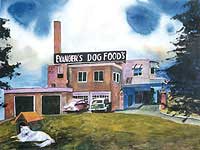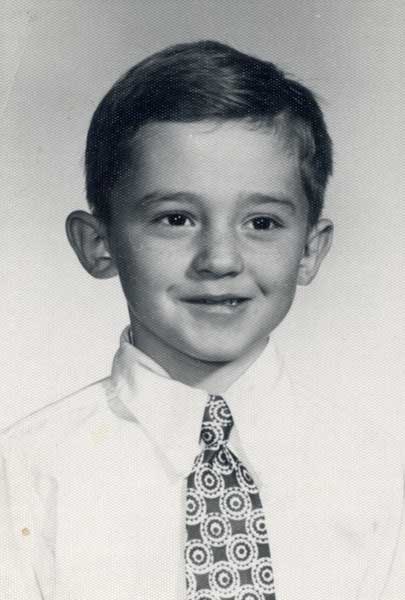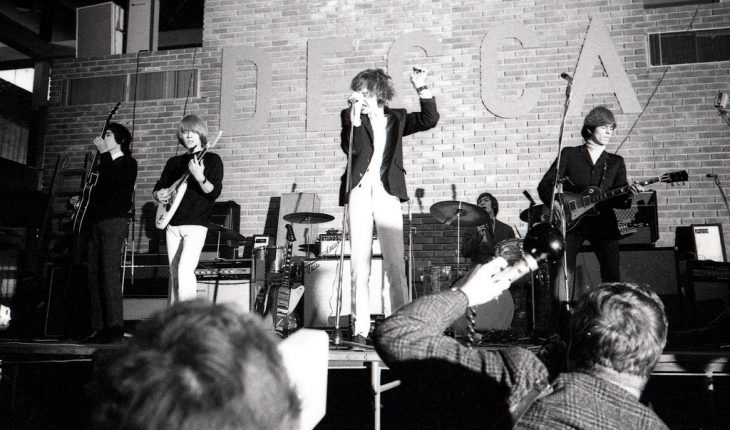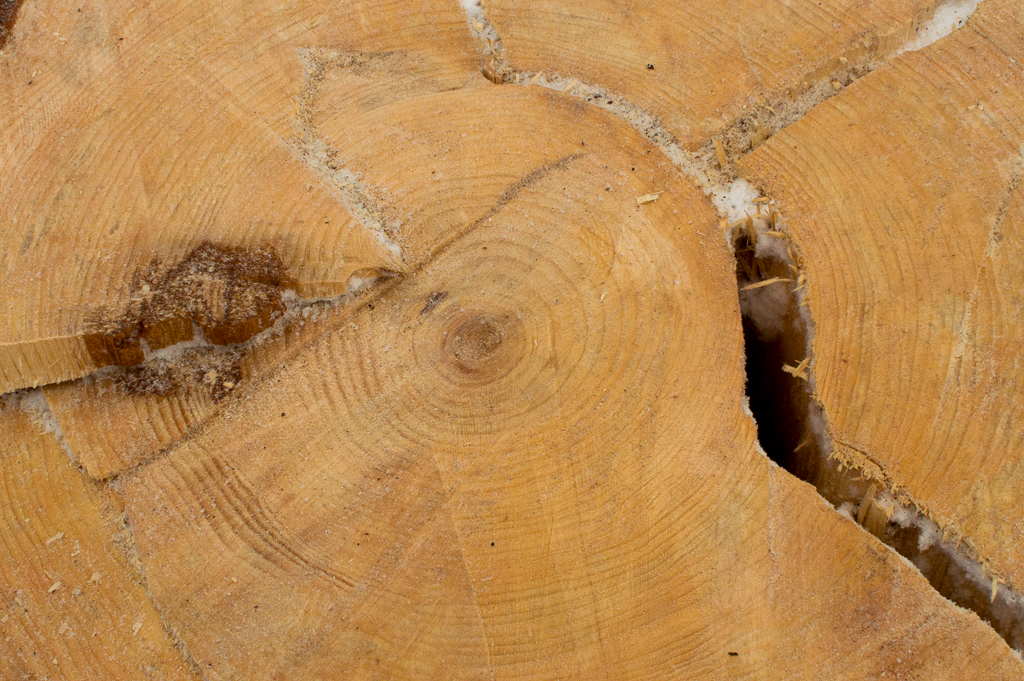My childhood began to roll on the sidewalks of Dover Street on the north side of Chicago…
and continued unrolling until 4th grade when we led the invasion of Wheeling, Illinois. Something brand new was infecting the surrounding farmland called a “subdivision.” It began like any cancer with a few cells that started to replicate. Outbreak hotspots, Rolling Meadows and Dunhurst Heights lured young, up-and-coming 1950’s couples and families with an opportunity to own a lot with a driveway, and a freestanding prefabricated pop-up home, an affordable “cracker box” out of the city.
My parents took me with them the night we went on a tour to select the features of our new home. Mom and Dad picked out a corner lot at 84 George Road. They signed a contract which let the developers start building. Ours was among the first fourteen homes built. Soon, we were packing boxes and moving out of our Winona Street apartment to what would come to be known as “the suburbs.” For a while, I played with my new found Dunhurst friends in a whirlwind construction zone. Cracker boxes sprouted from what was once a farmer’s fertile cabbage patch.
More than 500 homes eventually came to rest at the conjunction of Dundee and Elmhurst Roads.
Dunhurst Heights

Sometimes, we played in the crop rows surrounding the homes, eating and throwing heads of cabbage at each other. A little farther across that field and alongside the railroad tracks, was the Evanger’s Dog & Cat Food Company, a busy operation where old or unwanted horses were slaughtered and canned to feed people’s pets. The Evanger family had a kennel in front of the onsite corporate office with a pair of beautiful Great Danes whose pictures appeared on the label of each can.
I was enrolled in St. Mary’s Catholic School a few miles away in Buffalo Grove, a small rural parish next door to a cow pasture which was enclosed with an electric fence. The town had one gas station, Brehm’s garage, a restaurant, the church, and the school. Lots of new kids lived in Dunhurst, going to school with local farm kids who typically had horses and cows in their back yards. They taught us to hold a friend’s hand while fearlessly grabbing the electric fence wire to pass along a shocking practical joke. Sister Matilde loved baseball and every day at recess she would be outside pitching for both teams of little boys. She was eventually forbidden from playing ball by Mother Superior, apparently for having too much fun. That was a very sad day.
Bonnie Hass and Ellen Boden became my two best friends living nearby in Dunhurst. I can’t explain why my best friends were girls. Perhaps it was a little odd, but I didn’t realize it at the time. I also hung around with Bonnie’s cousin George Beattie, who lived right across the street. Dunhurst was a dynamic model of American consumerism, directly linked to social rank and status. People with corner lots outranked the ones with neighboring homes side-by-side. Some of the houses were built with brick… more expensive thus higher status. Then, people started to build garages – our two-car, attached garage with a screened-in porch connecting it to our house earned high rank. We added a lighted post lamp out by the sidewalk and many families followed suit. My mom was an avid gardener, surrounding the house with flower beds amid a plush lawn peppered with a few trees and bushes.
On school days, kids would wait for the bus at either the public or the Catholic school bus stops each morning, automatically standing in a line with our lunches packed in paper sacks or colorful tin lunch boxes. We St. Mary’s kids started every school day with Catholic Mass held in a dark, gothic church filled with old statuary, stained glass windows, lots of burning candles, a giant crucifix above the altar with a bleeding body nailed to it and a series of stations of the cross surrounding us on the walls. I didn’t know what the public school kids did each morning until I was eventually expelled from Catholic school in the 6th grade.
Then, I found out they started off with homeroom and announcements, followed by strange new classes like biology and phys ed. Yes, we all got naked together every day in the boys shower. It was a bit amazing and liberating, but I was a fat little kid, always a bit embarrassed at my physical incapacities. I can remember hanging like a postcard tuna suspended by my limp arms from the chin-up bar, unable to do even a single pull-up.
But I was smart… and that had status at Wheeling Public school, enough status to override the husky-butt issue. Nonetheless, I had a fat ass and ran almost as fast as a turtle. I remember trying out for little league, eventually getting to suit up in a team uniform, eventually getting my first hit, and starting to run for 1st base, which seemed about a thousand feet away, somewhere in the direction of right field – just follow the stripe. Of course, I was put out with a soft toss from the pitcher to the 1st baseman.
When I got back to the dugout, the coach beseeched me in mock amazement, “Hey Kastner, turn around!”
“Huh?” I also also wondered.
“I don’t see a piano on your back,” he taunted and thus shamed me in front of my giggling teammates. My love of sports sunk to a new low.
But, I loved girls and rock ‘n roll music. And some of them loved me. Noreen Alsdorf, a young amazon at Wheeling Elementary, took a particular liking to me and would on occasion, find isolated opportunities to engage me, literally overpowering and kissing me. She was beautiful, but stood at least a foot taller than everyone in the class and was much stronger than me. She had a pair of older, even bigger, twin brothers who must have extensively schooled her in combat.
I fell in love with Beatrice Neibur and Kay Messenger in that order. Beatrice loved to make out and taught me how to kiss. Kid parties back then always had a dark room for making out. We knew not where we were headed, but getting there was blissful and seemingly endless… until a parent eventually came in to open the doors (and windows) to let out the steam.
It was in the days of saddle shoes, pony tails and bucket purses, that Elvis came into focus one Sunday evening on the Ed Sullivan Show. I was a soft rocker before the King appeared, listening to Frank Sinatra, Harry Belafonte, Theresa Brewer, Pat Boone, and eventually awoke to the beat of Bill Hailey and the Comets. It seems now, like I was warming up an engine, starting at idle and then kicking it into higher and higher gears, Presley, Gene Vincent, Buddy Holly, The Big Bopper, Fabian, Fats Domino and an ever-increasing wave of musical energy revving up.
I have to credit my mother for spawning and nurturing my earliest interest and forthcoming love of music.

Ruthie was the one that found a little record store in Prospect Heights and shopped it with the same gusto that she applied to church bingo parties. She wanted to be a winner. She wanted to display prescience – the ability to pick through the newest releases, selecting the ones that would eventually become smash hits, weeks before they climbed to the top of the charts. She also loved betting on the horses at Belmont Park, with a special fondness for sulky racing and she often wore her hair in a pony tail.
My mom would regularly buy me a stack of new 45s and sure enough, I was cool because I was spinning the hits before they broke out of the pack. She was cool because she was a hit-picker, but she didn’t have much interest in actually listening to any of my 45s (vinyl 2-song disks recorded at 45 rpm with intended A and B sides, but on rare occasion both sides would become hits on the Top Forty). I played them alone in my room.
Our house was way more musical when my Dad was at home. Eugene loved jazz, Dixieland, piano, brass and vocalists. Mom and Dad always mentioned only one song as their favorite, “Stardust” by Glenn Miller. I think they fell in love and danced to it as teenagers… and at their wedding, before World War II split them apart for a while.
I was born in 1946 right after the war ended, probably conceived on or about New Year’s Eve at the end of 1945, a few months after we dropped atomic bombs on Japan and all of the sailors and soldiers came home. The baby boom, a flood of new babies was born following a wave of death and destruction.
I remember it was always crowded in school, every classroom filled to over-capacity, teachers trying to squeeze in just one more desk, nuns posing as educators, trying to tame and instruct a pack of thirty-five or forty kids; claustrophobic, energetic, and pre-pubescent. The “Brides of Christ” were as mean and sadistic as rumor has it. But, we kids created a hive-mind early on as a means of self-defense, a way to fight back. Note-passing became a fine art, as we grew especially skillful at long-distance delivery. We quickly learned to work together as a team.
Often the nuns would place me strategically in the midst of the good girls, trying to isolate me, surrounding me with obedient little A+ worker bees. I seemed to have a knack for corrupting them. And in the 5th grade, we managed to break two nuns and a lay teacher… literally, sending them to early retirement with what were then described as “nervous breakdowns.” We were supposed to feel guilty. Instead, we felt a strange triumphant sense of power – one that grew as the year advanced.
By the time spring arrived, the school authorities had exhausted all of their options. Our class had earned a reputation as untameable, simply because Catholic school kids sat together in one, single room all day – the same kids sat side-by-side polishing their skills. I would soon learn that public school kids switched classrooms many times each day and got rearranged regularly.
Fortunately, June arrived and school came to a close. My 6th grade year at St. Mary’s didn’t last very long as I think the “management” believed they had isolated the real 5th Grade problem – me. I vividly remember walking home barefoot down Buffalo Creek after being expelled for tormenting Mike Grady, who sat in the front row alongside the other teacher’s pets. From my seat in the back row, I managed to somehow invoke such anger in him that he rose out of his seat and ran to the back of the classroom and punched me. I was kicked out of class and sent packing. Thank you Jesus!
On September 9, 1956, Elvis made his first appearance on The Ed Sullivan Show. I was almost 10 years old. I wanted to become a juvenile delinquent after seeing Jailhouse Rock. I remember walking ahead of my Grandmother, who was kind enough to take me to see the film, with my collar turned up, a sure sign of delinquency. But my haircut was always a giveaway, cruel and undermining, it derailed any effort I might expend to be wicked.
My Dad was responsible for taking me to the barber shop where he called all of the shots.

After every shearing, I wanted to hide from the entire world for weeks until some hair grew back to cover my ears that naturally protruded out from my head. Cutting away the hair above them seemed to make my ears resemble large floppy wings, much like Dumbo’s. I did everything possible to negotiate for sideburns and longer hair but it was always denied – butch cut, crew cut, flat top, all through high school. Eventually, came the Beatles, but not soon enough.
Before freedom and rebellion in the 60s, there were the dark years spent in the south. For a number of reasons my Dad decided to leave his long-term employment with Contracting & Materials Company in Evanston to take up employment with Cohn Brothers Construction in Tampa, Florida. In the 7th grade, I found myself in a scary new world where everything I knew was sharply reversed. I was transformed from a witty, popular but “husky” boy at Wheeling Elementary to a fat “brain,” and a “yankee” at Sligh Junior High – home of the Red Devils.
Half of the kids there were bused in from Temple Terrace, an upper-crust development on the outskirts of Tampa that embraced an 18-hole golf course. Sligh Jr. High tried to be a melting pot, but mixing rich brats equally with some of Tampa’s toughest Puerto Rican kids from the poorest sections of the northeast side just didn’t work. Florida schools used “licks,” as physical punishment administered by the Dean to keep order by paddling kids with a flat wooden bat whenever you needed a few licks for correction. And the kids dealt out their own flavors of physical abuse as a social sport. There were rules and ongoing games of punishment like “frogging,” with penalties imposed upon the losers.
Imagine discretely drawing an imaginary letter X on someone’s upper arm with your finger. If that someone failed to notice and wipe it off before you counted to ten, you earned the undeniable right to “frog” them on the X-spot. Frogging was in itself an art form. You made a fist, but extended the central knuckle of your middle finger out a bit further than the others. With this instrument of pain, you struck the muscle of the victim with a staccato punch. If it was done right, the muscle popped out and then retracted, thus replicating the behavior of a frog. Most of us boys had black-and-blue spots on our arms and actually showed them off by rolling up our short-sleeved shirts a few tucks shorter yet.
The cool kids at Sligh had Cushman scooters with chrome pipes. It was all about machismo and physical strength in Florida. I remember cautiously correcting my math teacher, Mr. Pardo’s mistakes on the blackboard. He also taught Driver’s Ed. We watched film strips like Signal 30, a collection of graphically disturbing still shots of car accidents that included those of James Dean’s and Jayne Mansfield’s dead bodies. It was meant to impress us with shots of dismemberment. Florida was a 3-year nightmare, like a hall of mirrors when you were in it, not knowing while you were there if you would ever get back out. But I got my first driver’s license at 13 years of age under Florida law.
There were gators in the Hillsborough River and coral snakes and water moccasins on the banks. We had small stinging scorpions and nasty sharp things in the grass called sandspurs, the spikes of which would have to be removed from bare feet with a tweezers. Every summer afternoon was capped off with a sizzling electrical storm as the heat built to a breaking point at about 4 o’clock. The born-and-bred white locals were called “crackers” and they were racist and very fundamentally Christian.
In 1961, my chapter on Florida finally and unexpectedly came to a close. We moved back to the same northwest suburbs of Chicago. Despite the fact that I was essentially back home, everything there had changed while I was gone. My childhood classmates at Wheeling had become teenagers. The students from several regional elementary schools were now blended to populate Prospect High School. I was in a severe state of post traumatic shock before PTSD had been defined.
Music remained my refuge. I discovered folk music, broadsides, protest songs and poet songwriters. Phil Ochs, Malvina Reynolds, Pete Seeger, Joan Baez and eventually Bob Dylan became my heroes. I started learning to play the banjo first, then the guitar. At 16 years old, Kip Voorhees and I rode the bus to Newport, Rhode Island where we slept on the beach and attended several days of the Newport Folk Festival. I got to meet and talk with those same heroes. That was back in the days when Newport was very small and intimate, just for insiders.
Jim Smith worked at the record store in the new Randhurst Shopping Center. The employees often got comp tickets to concerts as part of the promotional materials for new artists with records to push. One day, Jim asked me if I wanted to see a new rock band from England appearing in Chicago on their first visit to America. Even though I was a folkie, I agreed to go with him to see The Beatles.
When we got to the Stockyards, it seemed like Jim and I were the only two guys in a sea of excited young girls. We could see the band playing on stage but heard nothing but the sounds of 3,000 screaming, sobbing girls. The entire hall was continuously and brightly lit from start to finish with what must have been hundreds of thousands of popping flash bulbs – “Sylvania Blue Dot for a sure shot.”
Towards the end of the concert, we decided to slip out early to beat the crowds. As we made our way toward the exits nearest the parking lot, we were suddenly swept back by security guards just as we were about to go out the door ahead. I looked back to see John, Paul, George, and Ringo running as fast as they could toward us with a breaking wave of young girls pursuing them as they dashed through the doorway just inches away. The Beatles jumped into a waiting limo just outside the doors, slid across the rear seat, and then exited right out of the opposite side door, getting into a second limo which was waiting beside the first. As it slipped away, the empty decoy limo was quickly surrounded by the pursuing girls who thought the band members were inside, while The Beatles sped safely away.
They were entertaining and fun, but it was another British band that would transform me from a “folkie” back to a true lover of rock ‘n roll. I can still remember the day Jim showed me a copy of the first album by the Rolling Stones. I shelled out the cash when he played, “I’m a King Bee.”

